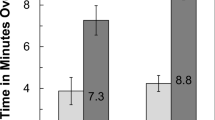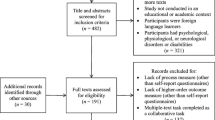Abstract
This paper reviews research suggesting that interest and importance are separate constructs mediated by concreteness and mental imagery, especially in expository text or other genres where concreteness and importance often diverge. Important expository material can be relatively more interesting or less interesting. If important expository material is concrete it tends to be interesting and well recalled. If important expository material is abstract and not well linked to concrete elaboration or examples it tends to be less interesting and less well recalled. Concrete elaboration of abstract ideas tends to improve students' recall. There appears to be no harm in adding concrete detail to well structured, coherent text to promote interest unless enough is added so that a new text with a different coherence emerges. Making already concrete text more emotionally interesting may have little effect. Using a coherent text structure that adequately implies or signals importance and supporting important information with concrete explanation are key text design implications. Dual Coding Theory provides a systematic theoretical account of the findings in this area.
Similar content being viewed by others
References
Asher, S. R. (1980). Topic interest in children's reading comprehension. In Spiro, R. J., Bruce, B. C., and Brewer, W. F. (eds.), Theoretical Issues In Reading Comprehension, Erlbaum, Hillsdale, NJ, pp. 525–534.
Beck, I. L., McKeown, M. G., and Worthy, J. (1995). Giving text voice can improve students' understanding. Reading Res. Q. 30: 220–238.
Campbell, J. A. (1974). Charles Darwin and the crisis of ecology: A rhetorical perspective. Q. J. Speech 55: 442–449.
Clark, J. M., and Paivio, A. (1991). Dual coding theory and education. Educ. Psychol. Rev. 3: 149–210.
d'Ailly, H. H., Murray, H. G., and Corkill, A. (1995). The cognitive effects of self-referencing. J. Contemp. Educ. Psychol. 20: 88–113.
d'Ailly, H. H., Simpson, J., and MacKinnon, G. E. (1997). Where should ‘you’ go in a math compare problem? J. Educ. Psychol. 89: 562–567.
Dewey, J. (1916). Democracy and Education, Macmillan, New York.
Estes, T. H. (1982). The nature and structure of text. In Berger, A., and Robinson, H. A. (eds.), Secondary School Reading: What Research Reveals for Classroom Practice, ERIC Clearinghouse on Reading and Communication Skills and the National Conference on Research in English, Urbana, IL, pp. 85–96.
Garner, R., and Gillingham, M. G. (1991). Topic knowledge, cognitive interest, and text recall: A microanalysis. J. Exp. Educ. 59: 310–319.
Garner, R., Gillingham, M. G., and White, C. S. (1989). Effects of “seductive details” on macroprocessing and microprocessing in adults and children. Cogn. Instr. 6: 41–57.
Goetz, E. T., and Sadoski, M. (1995a). The perils of seduction: Distracting details or incomprehensible abstractions? Reading Res. Q. 30: 500–511.
Goetz, E. T., and Sadoski, M. (1995b). The perils of seduction revisited: A reply to Wade, Alexander, Schraw, and Kulikowich. Reading Res. Q. 30: 518–519.
Goetz, E.T., Sadoski, M., Fatemi, Z., and Bush, R. (1994).That's news to me: Readers' responses to brief newspaper articles. J. Reading Behav. 26: 125–138.
Goetz, E. T., Sadoski, M., and Olivarez, A.,Jr. (1991). Getting a reading on reader response: Relationships between imagery, affect, and importance ratings, recall and imagery reports. Reading Psychol. 12: 13–26.
Harp, S. F., and Mayer, R. E. (1997). The role of interest in learning from scientific text and illustrations: On the distinction between emotional interest and cognitive interest. J. Educ. Psychol. 89: 92–102.
Harp, S. F., and Mayer, R. E. (1998). How seductive details do their damage: A theory of cognitive interest in science learning. J. Educ. Psychol. 90: 414–434.
Hegarty, P. (1995). Seductive details re-examined: The effects of interesting details on learning from text. Paper presented at the Annual Meeting of the American Educational Research Association, San Francisco, CA, April 1995.
Hidi, S., and Baird, W. H. (1988). Strategies for increasing text-based interest and students' recall of expository texts. Reading Res. Q. 23: 465–483.
Hidi, S., Baird, W., and Hilyard, A. (1982). That's important but is it interesting? Two factors in text processing. In Flammer, A., and Kintsch, W. (eds.), Discourse Processing, North-Holland, Amsterdam, pp. 63–75.
Marks, D. F. (1973). Visual imagery differences in the recall of pictures. Br. J. Psychol. 64: 17–24.
McKelvie, S. J. (1995). The VVIQ as a psychometric test of individual differences in visual imagery vividness: A quantitative review and plea for direction. J. Ment. Imagery 19: 1–106.
Paivio, A. (1986). Mental Representations: A Dual Coding Approach, Oxford University Press, New York.
Pauling, L. (1983). Throwing the book at elementary chemistry. Sci. Teacher 50: 25–29.
Paxton, R. J. (1999). A deafening silence: History textbooks and students who read them. Rev. Educ. Res. 69: 315–339.
Pedhazur, E. (1982). Multiple Regression in Behavioral Research, 2nd edn., Holt, Rinehart, and Winston, New York.
Richardson, A. (1994). Individual Differences in Imaging: Their Measurement, Origins, and Consequences, Baywood, Amityville, NY.
Sadoski, M. (1983). An exploratory study of the relationships between reported imagery and the comprehension and recall of a story. Reading Res. Q. 19: 110–123.
Sadoski, M. (1985). The natural use of imagery in story comprehension and recall: Replication and extension. Reading Res. Q. 20: 658–667.
Sadoski, M. (1999). Theoretical, empirical, and practical considerations in designing informational text. Doc. Design 1: 25–34.
Sadoski, M., Goetz, E. T., and Fritz, J. (1993a). A causal model of sentence recall: Effects of familiarity, concreteness, comprehensibility, and interestingness. J. Reading Behav. 25: 5–16.
Sadoski, M., Goetz, E. T., and Fritz, J. (1993b). Impact of concreteness on comprehensibility, interest, and memory for text: Implications for dual coding theory and text design. J. Educ. Psychol.85: 291–304.
Sadoski, M., Goetz, E. T., and Kangiser, S. (1988). Imagination in story response: Relationships between imagery, affect, and structural importance. Reading Res. Q. 23: 320–336.
Sadoski, M., Goetz, E. T., Olivarez, A., Lee, S., and Roberts, N.M. (1990). Imagination in story reading: The role of imagery, verbal recall, story analysis, and processing levels. J. Reading Behav. 22: 55–70.
Sadoski, M., Goetz, E. T., and Rodriguez, M. (2000). Engaging texts: Effects of concreteness on comprehensibility, interest, and recall in four text types. J. Educ. Psychol. 92: 85–95.
Sadoski, M., and Paivio, A. (1994). A dual coding view of imagery and verbal processes in reading comprehension. In Ruddell, R.B., Ruddell, M. R., and Singer, H. (eds.), Theoretical Models and Processes of Reading, (4th edn.), International Reading Association, Newark, DE, pp. 582–601.
Sadoski, M., and Paivio, A. (2001). Imagery and Text: A Dual Coding Theory of Reading and Writing, Erlbaum, Mahwah, NJ.
Sadoski, M., Paivio, A., and Goetz, E. T. (1991). A critique of schema theory in reading and a dual coding alternative. Reading Res. Q. 26: 463–484.
Sadoski, M., and Quast, Z. (1990). Reader response and long term recall for journalistic text: The roles of imagery, affect, and importance. Reading Res. Q. 25: 256–272.
Sewall, G. T. (1987). American History Textbooks: An Assessment of Quality, Educational Excellence Network,Teachers College, Columbia University, NewYork.(ERICDocument Reproduction Service no. ED 289 807)
Sewall, G. (1988). Literary lackluster: The unhappy state of American history textbooks. Am. Educ. 12: 32–37.
Schraw, G. (1998). Processing and recall differences among seductive details. J. Educ. Psychol. 90: 3–12.
Spooren, W., Mulder, M., and Hoeken, H. (1998). The role of interest and text structure in professional reading. J. Res. Reading 21: 109–120.
Strunk W., Jr., and White, E. B. (1979). The Elements of Style, (3rd edn.) Macmillan, NewYork.
Wade, S. E., and Adams, R.B. (1990). Effects of importance and interest on recall of biographical text. J. Reading Behav. 22: 331–353.
Wade, S., Alexander, P., Schraw, G., and Kulikowich, J. (1995).The perils of criticism:Aresponse to Goetz and Sadoski. Reading Res. Q. 30: 512–515.
Wade, S. E., Buxton, W. M., and Kelly, M. (1999). Using think-alouds to examine reader-text interest. Reading Res. Q. 34: 194–216.
Wade, S. E., Schraw, G., Buxton, W. M., and Hayes, M. T. (1993). Seduction of the strategic reader: Effects of interest on strategies and recall. Reading Res. Q. 28: 92–114.
Wharton, W. P. (1980). Higher imagery and the readability of college history texts. J. Ment. Imagery 4: 129–147.
Author information
Authors and Affiliations
Rights and permissions
About this article
Cite this article
Sadoski, M. Resolving the Effects of Concreteness on Interest, Comprehension, and Learning Important Ideas From Text. Educational Psychology Review 13, 263–281 (2001). https://doi.org/10.1023/A:1016675822931
Issue Date:
DOI: https://doi.org/10.1023/A:1016675822931




